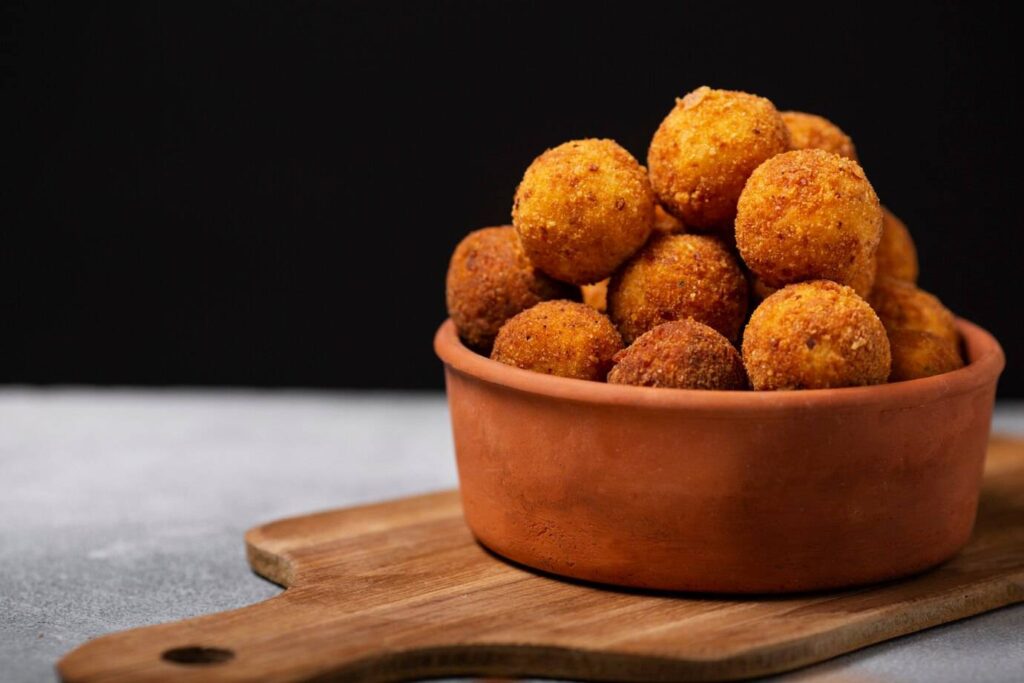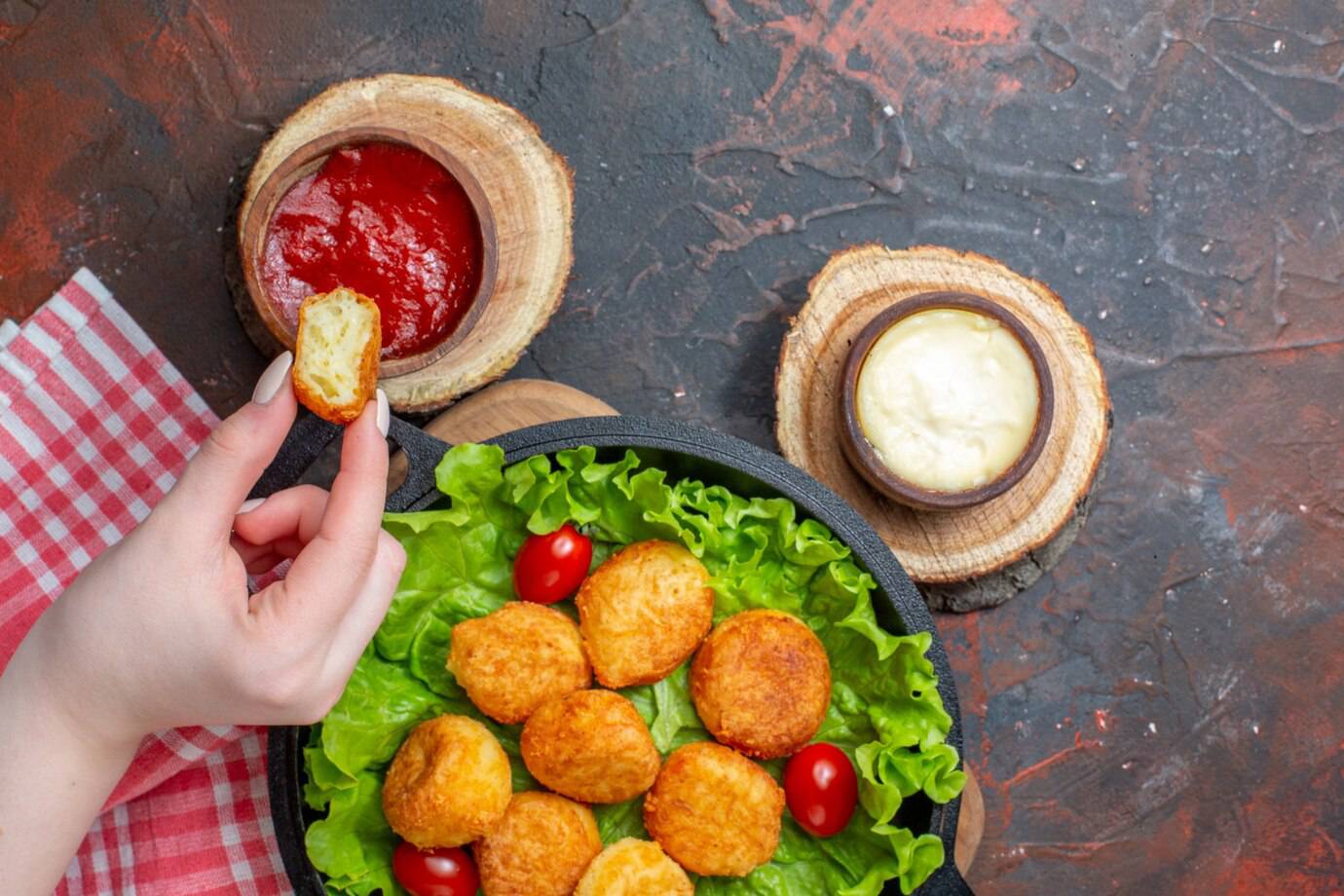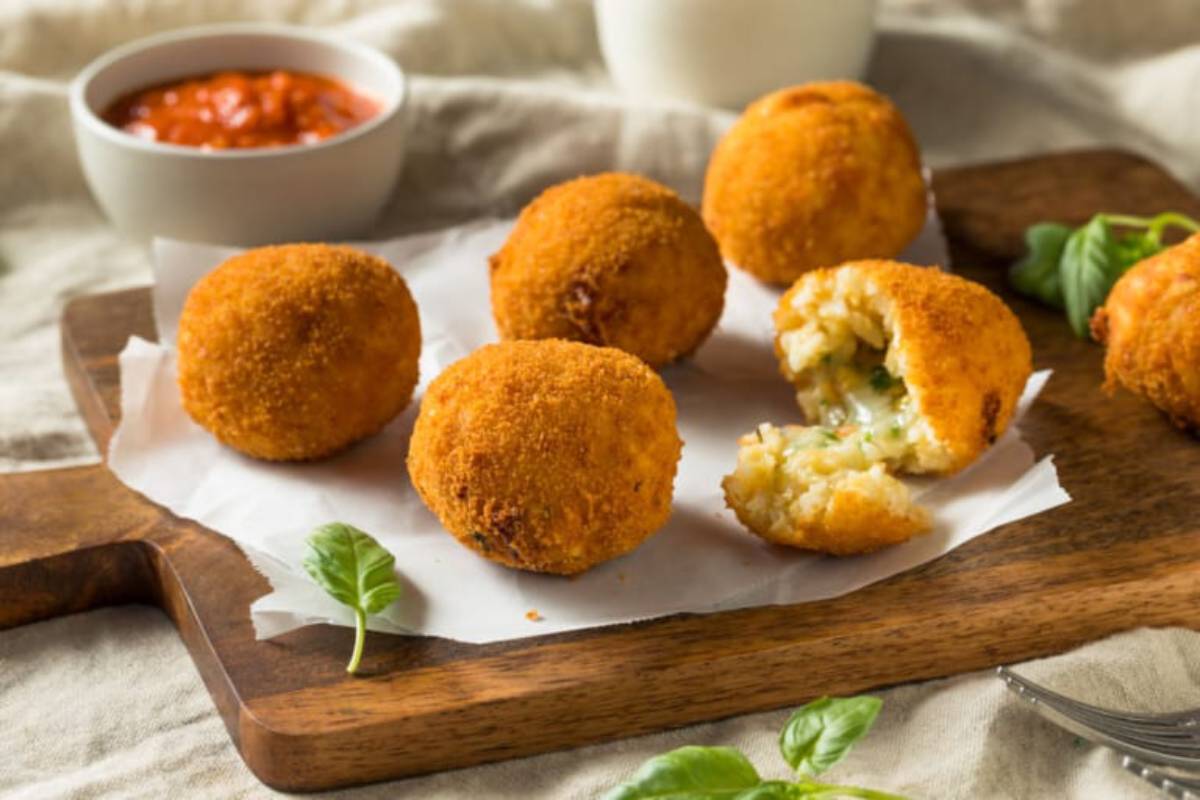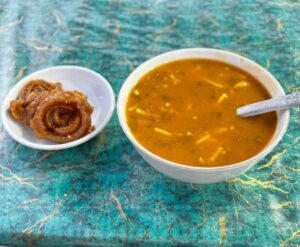The Food & Recipes Blog

Italian Arancini Balls: Crispy and Portable
Biting into a golden, crisp arancino is irresistibly comforting, especially when the filling reveals warm, creamy risotto (with oozing cheese or savoury ragù), the ingredient in our favourite Italian snack. Arancini balls are a true Sicilian street food gem, but their reputation has travelled far beyond Italy’s southern coast.
Whether savoured on a busy street stall in Palermo or at a joyful occasion, these Italian snacks aren’t just an excellent combination of crunch and flavour, merging traditional with innovative culinary ideas. In this blog, we’ll delve into the origins of arancini balls in Italy, explore how they’re made, and uncover why they’ve become a must-try treat for food lovers worldwide.
What Are Arancini Balls?
Arancini (singular: arancino or arancina, depending on the region) are deep-fried rice balls typically filled with various savoury ingredients. They are usually coated in breadcrumbs before being fried to perfection.
Typical fillings include:
- Ragù (meat sauce with tomato)
- Mozzarella or caciocavallo cheese
- Green peas
- Ham or prosciutto
- Mushrooms or spinach
These Italian snacks are often made using leftover risotto, making them a clever way to reduce food waste while enjoying a flavour-packed meal on the go.
The Origin Story: Arancini’s Sicilian Roots
Arancini dates back to the 10th-century Sicily, during Arab rule on the island. The Arabs introduced rice to Sicily, along with saffron, which is often used to give arancini their signature golden hue.
The name arancini is derived from the Italian word arancia, meaning “orange”, because the fried balls resemble small oranges in shape and colour.
Regional Variations Across Sicily
Arancini are not uniform across the island. There’s a fierce local rivalry over how they should be shaped and filled:
- In Palermo, they’re called arancina (feminine) and are typically round.
- In Catania, they’re arancino (masculine) and often cone-shaped to resemble Mount Etna.
Despite the differences, the unifying theme remains: a crunchy breadcrumb crust and a rich, comforting interior.
How Are Arancini Made?
While arancini may look simple on the surface, crafting the perfect ball takes skill, timing, and high-quality ingredients.
The Basic Steps:
- Prepare the risotto – Typically cooked with saffron and cooled before shaping.
- Add the filling – A spoonful of ragù, cheese, or another filling is added at the centre.
- Shape the balls – Formed into either spheres or cones.
- Coat and fry – Dipped in egg, rolled in breadcrumbs, and deep-fried until golden.
This method results in a truly addictive contrast of textures: crispy on the outside and creamy on the inside.
Ingredient Tip:
Using carnaroli or arborio rice helps the arancini hold their shape due to their high starch content, resulting in a creamy yet firm base.
Why Arancini Are the Ultimate Italian Snack
Arancini balls are more than just tasty—they’re versatile, portable, and satisfying, making them a favourite for Italians of all ages.
Key Reasons to Love Arancini:
- Portable: Perfect for eating on the go—no utensils needed.
- Adaptable: Can be made vegetarian, gluten-free, or filled with whatever you have on hand.
- Economical: A great way to use up leftover risotto or cheese.
- Kid-friendly: Loved by picky eaters and adventurous foodies alike.
In Sicily, they’re a popular street food for lunch, dinner, or even a hearty snack between meals.
Beyond Sicily: Arancini Around the World
The popularity of arancini balls has exploded beyond Italy. These snacks have found global appeal, from Italian delis in London to gourmet food trucks in Toronto.
Examples of Modern Twists:
- Vegan arancini – Made with plant-based cheese and vegetables.
- Truffle mushroom arancini – A luxurious take featuring earthy truffle oil and creamy mushrooms.
- Spinach and ricotta arancini – A vegetarian-friendly version that still delivers rich flavour.

Restaurants and home cooks are putting their stamp on arancini, proving the dish’s adaptability.
Nutritional Value and Dietary Considerations
While arancini are undeniably indulgent, they can be made more health-conscious with a few adjustments:
Nutritional Highlights (per traditional arancino):

- Calories: 250–350, depending on filling and size
- Protein: 8–12g
- Carbohydrates: 30–40g
- Fat: 10–18g
Healthier Versions:
- Bake instead of deep-frying to reduce fat
- Use brown rice or quinoa for added fibre
- Add vegetables for increased nutritional content
How to Make Arancini at Home: A Simple Recipe
Making arancini from scratch is a rewarding kitchen project. Here’s a basic recipe to get you started:
Ingredients:
- 2 cups cooked risotto (cooled)
- ½ cup grated Parmesan
- 1 egg
- 100g mozzarella, cubed
- 1 cup plain flour
- 2 eggs, beaten
- 1½ cups breadcrumbs
- Oil for frying
Instructions:
- Mix the cooled risotto with Parmesan and one egg.
- Form a risotto ball, place a mozzarella cube in the centre, and seal.
- Roll in flour, dip in egg, then coat in breadcrumbs.
- Fry in hot oil (180°C) until golden (approx. 3–4 minutes).
- Drain on paper towels and serve hot.
Tip: Chill the shaped balls before frying to help maintain structure.
Arancini in Italian Culture and Celebrations
In Sicily, arancini are particularly popular during festivals such as Santa Lucia Day (December 13), during which — in a show of solidarity with the saint — eating bread and pasta is eschewed, and rice-based dishes take centre stage.
They also make an appearance at weddings, birthdays and religious holidays, part of antipasti spreads or snack tables. Their festive appeal is due to their comforting flavour and attractive appearance, plus, they are easy to share.
Where to Try Authentic Arancini in Italy
If you ever find yourself in Sicily, don’t miss the opportunity to try freshly made arancini from a local rosticceria (rotisserie shop). Some top-rated spots include:
- Antica Focacceria San Francesco – Palermo
- Savia – Catania
- Bar Touring – Taormina
These places are renowned for their crispy crusts and creative fillings, offering traditional and modern options to suit all tastes.
Arancini vs. Supplì: What’s the Difference?
While arancini are Sicilian, supplì are their Roman cousins. Both are fried rice balls, but there are subtle differences:
| Feature | Arancini | Supplì |
| Origin | Sicily | Rome |
| Shape | Round or cone-shaped | Oval |
| Common Filling | Ragù, peas, mozzarella | Mozzarella with tomato rice |
| Coating | Breadcrumbs | Breadcrumbs |
Crispy Comfort with Cultural Roots
Call them arancini, arancini, or just “those amazing Italian rice balls,” there’s no denying their international appeal. Crispy and easy to eat on the go, these humble snacks capture the essence of Sicilian street food—ingenious, delicious, and steeped in heritage.
From their humble origins to their worldwide fame, arancini balls speak volumes about the joy of Italian culinary culture. Whether you’re tasting them in Sicily, replicating them back home, or testing out modern takes abroad, each bite is a snapshot of a beloved food heritage.
Are you ready to enjoy the crispy magic of some arancini? Make your own, or find an Italian deli nearby to experience a freshly made version. However you like them, arancini will leave you wanting another bite.
Want more stories about Italian food? Weekly posts touch on insights, traditional recipes, and food finds from Italy and beyond– Subscribe to our blog!









